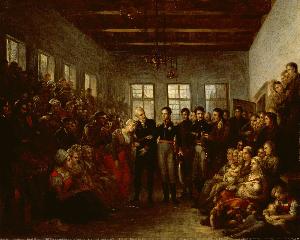Mattheus Ignatius Van Bree
Mathieu Ignace Van Brée;Mattheus Ignatius Van Bree;Mathieu Ignace Van Bree
Place: Antwerp
Born: 1773
Death: 1839
Biography:
Mattheus Ignatius van Bree was a Belgian painter, born in Antwerp in 1773 and died in the same city in 1839. He was one of the founders of the historical school of painting in Belgium and played an important role as a teacher in the development of 19th-century Belgian art.
Early Life and Training
Mattheus Ignatius van Breewas first trained from the age of 10 in the local art academy, where one of his teachers was Petrus Johannes van Regemorter. He became assistant-professor at the Academy and got his own studio in 1794. In 1797, he left for Paris where he studied with François-André Vincent. During his time in Paris, he participated in the Paris Salon and won second prize in the Prix de Rome with his painting The death of Cato in Utica.
Career and Style
After returning to Antwerp, Mattheus Ignatius van Bree became a teacher at the re-opened Academy in 1804. He executed historical subjects and portraits in a stark neo-classical style owing much to both David and Vincent. Later, his style became more reminiscent of Rubens in its use of looser brushwork and a warmer palette. His historical paintings were often of large dimensions and earned him a high reputation in his lifetime.
Notable Works and Students
Some of his most important works include The Patriotism of the Burgomaster Van der Werft, in the city hall of Leyden, and The Death of Rubens, in the Royal Museum of Fine Arts, Antwerp. He also trained some of the eminent painters of the next generation, such as Egide Charles Gustave Wappers, Nicaise de Keyser, and Jan August Hendrik Leys. Key Facts:
- Mattheus Ignatius van Bree was a member of the commission responsible for recovering works of art confiscated by the French.
- He was able to retrieve many works by Rubens.
- In 1821, he traveled to Italy and visited Florence and Rome with his former pupil Ferdinand de Braekeleer the Elder.
- He published his views on art in Leçons de dessin (Drawing lessons) in 1821.
For more information about Mattheus Ignatius van Bree and other artists, visit the Mattheus Ignatius van Bree website or check out his page on Petrus Johannes van Regemorter. You can also explore the works of other notable artists, such as Nicaise de Keyser and Jan August Hendrik Leys, on their respective pages on François-André Vincent and The death of Cato in Utica.




